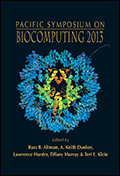Epigenomic Model of Cardiac Enhancers with Application to Genome Wide Association Studies
Avinash Das Sahu1, Radhouane Aniba2, Yen-Pei Christy Chang3, Sridhar Hannenhalli4
1Center for Bioinformatics and Computational Biology;22 School of Medicine, University of Maryland
Email: sridhar@umiacs.umd.edu
Pacific Symposium on Biocomputing 18:92-102(2013)

Abstract
Mammalian gene regulation is often mediated by distal enhancer elements, in particular, for tissue speci?c and developmental genes. Computational identi?cation of enhancers is di?cult because they do not exhibit clear location preference relative to their target gene and also because they lack clearly distinguishing genomic features. This represents a major challenge in deciphering transcrip- tional regulation. Recent ChIP-seq based genome-wide investigation of epigenomic modi?cations have revealed that enhancers are often enriched for certain epigenomic marks. Here we utilize the epigenomic data in human heart tissue along with validated human heart enhancers to develop a Support Vector Machine (SVM) model of cardiac enhancers. Cross-validation classi?cation accuracy of our model was 84% and 92% on positive and negative sets respectively with ROC AUC = 0.92. More importantly, while P300 binding has been used as gold standard for enhancers, our model can distinguish P300-bound validated enhancers from other P300-bound regions that failed to exhibit enhancer activity in transgenic mouse. While GWAS studies reveal polymorphic regions associated with certain phenotypes, they do not immediately provide causality. Next, we hypothesized that ge- nomic regions containing a GWAS SNP associated with a cardiac phenotype might contain another SNP in a cardiac enhancer, which presumably mediates the phenotype. Starting with a comprehen- sive set of SNPs associated with cardiac phenotypes in GWAS studies, we scored other SNPs in LD with the GWAS SNP according to its probability of being an enhancer and choose one with best score in the LD as enhancer. We found that our predicted enhancers are enriched for known cardiac transcriptional regulator motifs and are likely to regulate the nearby gene. Importantly, these ten- dencies are more favorable for the predicted enhancers compared with an approach that uses P300 binding as a marker of enhancer activity.
[Full-Text PDF] [PSB Home Page]